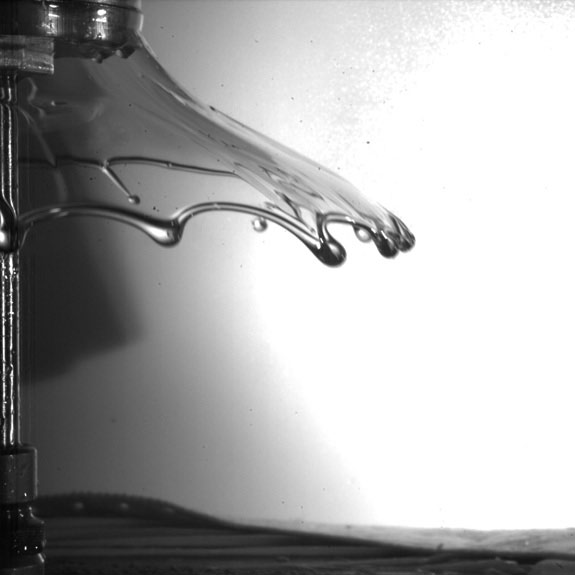Clapping Wet Hands
Brian Chang
Brice Slama
Sunghwan Jung
Department of Engineering Science and Engineering
Virginia Tech

B. Chang, B. Slama and S. Jung at Virginia Tech A snapshot of the rapid compression of silicone oil between two plates. The photograph shows the sheet and rim of a liquid moments before it breaks up into droplets and ligaments.
Inspired by children clapping their wet hands, the authors of this image demonstrate how a resting fluid is squeezed by colliding two flat plates. Rapid compression causes the fluid to eject radially, first forming a smooth sheet of liquid with a thicker rim (called a "ligament") at its outer edge, and subsequently generating wavy edges within the fluid sheet and droplets flying outward at a high speed.
This image shows a snapshot of the rim and sheet of a liquid moments before it breaks up into droplets and ligaments. A volume of silicone oil is placed on the bottom of two circular plates. When the top plate collides with the bottom plate, the oil is ejected outwards. One can see the thick rim forming along the outer edge of the fluid, as well as the thin fluid sheet following it.
Instabilities cause the rim to begin to form waves as it expands. Gravity pulls the rim and the sheet down during this expansion, creating the curtain-like shape shown in this image. Moments after this picture was taken, instabilities would have caused the sheet of fluid to break up into ligaments and the rim to form droplets.
Acknowledgment is made to the donors of American Chemical Society Petroleum Research Fund (PRF# 52332-DNI9) for partial support of this research.
Reporters and Editors
This image can be freely reproduced with the accompanying credit: "B. Chang, B. Slama and S. Jung at Virginia Tech."
Contact Information
Sunghwan(Sunny) Jung
Assistant Professor, Engineering Science & Mechanics,
228 Norris Hall, Virginia Tech, Blacksburg, VA
sunnyjsh@gmail.com
